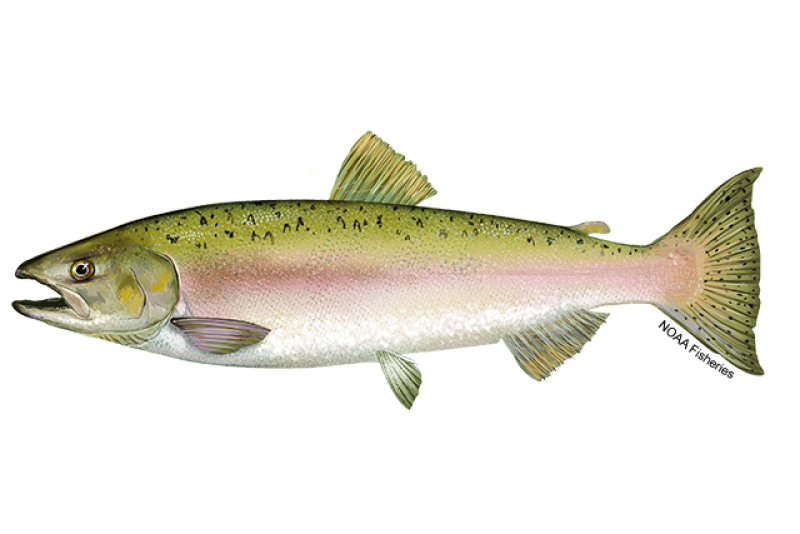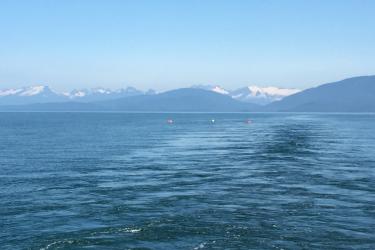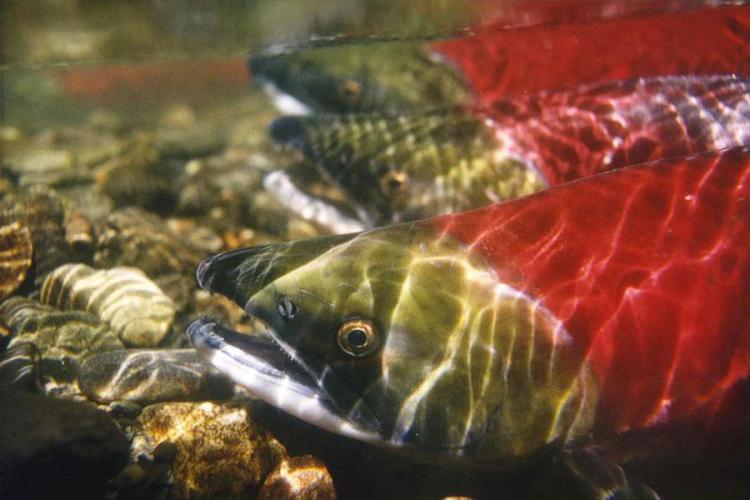 Sockeye salmon. Credit: NOAA Fisheries
Sockeye salmon. Credit: NOAA Fisheries
Sockeye salmon. Credit: NOAA Fisheries
About the Species
 Sockeye salmon. Credit: NOAA Fisheries
Sockeye salmon. Credit: NOAA Fisheries
Sockeye salmon. Credit: NOAA Fisheries
U.S. wild-caught sockeye salmon is a smart seafood choice because it is sustainably managed and responsibly harvested under U.S. regulations.
NOAA Fisheries works in cooperation with federal, state, tribal, and Canadian officials to manage these commercial, recreational, and tribal harvest of salmon and steelhead in ocean and inland waters of the West Coast and Alaska. To learn more about management of these fisheries, visit our West Coast and Alaska fisheries management pages.
However, some sockeye salmon are also protected under the Endangered Species Act. Learn more about protected sockeye salmon.
Appearance
- Sockeye is one of the smaller species of Pacific salmon, measuring 1.5 to 2.5 feet in length and weighing 4 to 15 pounds.
- Kokanee (non-anadromous sockeye) rarely exceed 1.2 feet in length.
- Sea-going sockeye salmon have iridescent silver flanks, a white belly, and a metallic green-blue top, giving them their "blueback" name.
- Some fine black speckling may occur on the back, but the large spots typical of other Pacific salmon are absent. There are no spots on the fins, including the tail.
- As sockeye salmon return to their freshwater spawning grounds, their heads turn green and their bodies turn bright red, hence their other common name in Alaska is “red” salmon.
- Spawning males develop a humped back and hooked jaws filled with tiny, visible teeth.
Biology
- Most sockeye salmon are anadromous—they hatch in freshwater streams and rivers or lakes and generally rear in freshwater lakes for 1 to 3 years, after which they reach the smolt stage and migrate to the ocean to feed and grow.
- They typically mature and return to fresh water after 2 to 3 years at sea, but some return earlier or stay at sea longer, between 4 and 5 years.
- Sockeye salmon that return earlier are almost always males and are called "jacks."
- They typically spawn in the summer or fall.
- Females select spawning sites, dig nests (redds) with their tails, and deposit eggs (between 2,000 and 4,500) in the redds.
- Males swim over the redds and fertilize the eggs.
- Females cover their eggs with gravel using their tails.
- The eggs hatch during the winter, and the newly hatched salmon (alevins) remain in the gravel, living off the material stored in their yolk sacs until early spring.
- They then emerge as fry and spend 1 to 3 years in fresh water before reaching the smolt stage and migrating out to the ocean, usually in the spring.
- All sockeye salmon die within a few weeks after spawning.
- They sexually mature around the age of 5, which means their lifespan is about 5 years, although some live longer. Age 4 is more common in the Pacific Northwest.
- While in fresh water, juvenile sockeye salmon feed mainly on zooplankton (tiny floating animals), amphipods (small, shrimp-like crustaceans), and insects.
- In the ocean, sockeye salmon continue to feed on zooplankton but also eat larval and small adult fishes and occasionally squid.
- Fish (including other salmon) and birds feed on juvenile salmon.
- Sharks, lampreys, and marine mammals prey on adult salmon in the ocean. Bears, eagles, and occasionally wolves feed on sockeye salmon in fresh water.
- After salmon spawn and die, salmon carcasses are a valuable source of energy and nutrients to the river ecosystem. Carcasses have been shown to improve newly hatched salmon growth and survival by contributing nitrogen and phosphorous compounds to streams.
Where They Live
Range
- Northwest Alaska to the Deschutes River in Oregon.
Habitat
- Freshwater lakes, streams, estuaries, and associated wetlands provide vital nursery grounds for sockeye salmon.
- Anadromous sockeye migrate from fresh water habitats to the ocean to further grow, feed, and mature.
- Adult salmon leave the ocean, enter fresh water, and migrate many miles upstream to spawn, usually in the stream or lake of their birth.
- Some sockeye salmon are not anadromous and spend their entire lives in freshwater.
- In the Pacific Northwest, non-anadromous sockeye are known as "kokanee."
Scientific Classification
- Northwest Alaska to the Deschutes River in Oregon.
- Freshwater lakes, streams, estuaries, and associated wetlands provide vital nursery grounds for sockeye salmon.
- Anadromous sockeye migrate from fresh water habitats to the ocean to further grow, feed, and mature.
- Adult salmon leave the ocean, enter fresh water, and migrate many miles upstream to spawn, usually in the stream or lake of their birth.
- Some sockeye salmon are not anadromous and spend their entire lives in freshwater.
- In the Pacific Northwest, non-anadromous sockeye are known as "kokanee."
Scientific Classification
| Kingdom | Animalia | Phylum | Chordata | Class | Actinopterygii | Order | Salmoniformes | Family | Salmonidae | Genus | Oncorhynchus | Species | nerka |
|---|
Last updated by NOAA Fisheries on 04/01/2025
Featured News
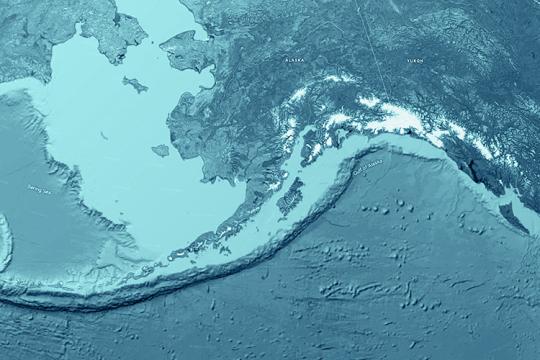 3D render and imaging of topographic map of Alaska showing the Gulf of Alaska, Aleutian Islands and Bering Sea. Satellite images courtesy of NASA. Credit: Frank Ramspott
3D render and imaging of topographic map of Alaska showing the Gulf of Alaska, Aleutian Islands and Bering Sea. Satellite images courtesy of NASA. Credit: Frank Ramspott
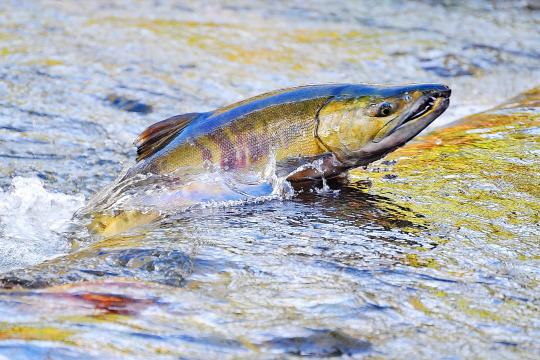 Chum salmon swimming upstream to spawn in Washington. Credit: iStock
Chum salmon swimming upstream to spawn in Washington. Credit: iStock
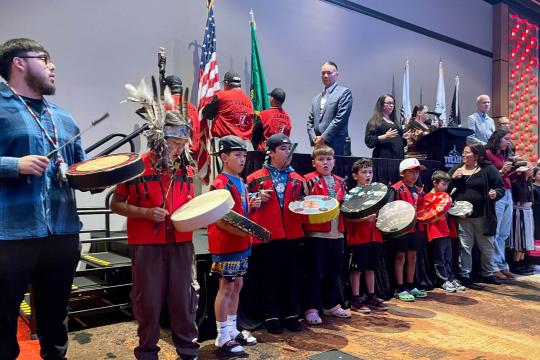 Tulalip tribal youth singers and dancers kicked off the celebration of new federal funding for tribal fish hatcheries.
Tulalip tribal youth singers and dancers kicked off the celebration of new federal funding for tribal fish hatcheries.
Federal and Tribal Leaders Celebrate $240 Million for Tribal Hatchery Modernization
 Bryan Cormack, fisheries biologist at the Alaska Fisheries Science Center, uses a multi-channel pipette for streamlined high-throughput processing using the sulfo-phospho-vanillin (SPV) assay. He processed more than 2,700 SPV samples this past year. Credit: NOAA Fisheries/Cody Pinger.
Bryan Cormack, fisheries biologist at the Alaska Fisheries Science Center, uses a multi-channel pipette for streamlined high-throughput processing using the sulfo-phospho-vanillin (SPV) assay. He processed more than 2,700 SPV samples this past year. Credit: NOAA Fisheries/Cody Pinger.
Seafood Facts

Is Sockeye Salmon Sustainable?
U.S. wild-caught sockeye salmon is a smart seafood choice because it is sustainably managed and responsibly harvested under U.S. regulations.
Availability
Fresh summer and early fall. Frozen, canned, and smoked year-round.
Source
Alaska to Oregon.
Taste
Rich flavor that rivals the flavor of Chinook (king) salmon.
Texture
Firm and fatty, making it rich in omega-3 fatty acids.
Color
Reddest flesh of the wild salmon species. The raw meat has a bright-red or orange-red color. Cooked meat remains red.
Health Benefits
Sockeye salmon is low in sodium and is a good source of omega-3 fatty acids.
Nutrition Facts
Servings: 1; Serving Weight: 100 g (raw); Calories: 168; Protein: 21.3 g; Total Fat: 8.56 g; Total Saturated Fatty Acids: 1.495 g; Carbohydrate: 0 g; Total Sugars: 0 g; Total Dietary Fiber: 0 g; Cholesterol: 62 mg; Selenium: 33.7 mcg; Sodium: 47 mgMore Information
Sockeye Salmon Recipes
Sockeye has a bold, buttery flavor similar to chinook and is rich in omega 3. If you’re looking for cooking inspiration, browse these recipes for salmon sushi cups, grilled sockeye, and more!

Last updated by NOAA Fisheries on 04/01/2025
Seafood News
 Fresh-caught taʻape on ice. Credit: Conservation International Hawaiʻi.
Fresh-caught taʻape on ice. Credit: Conservation International Hawaiʻi.
Reducing Waste and Feeding Communities in Hawaiʻi with a Whole Fish Approach
 Chef Tyler Hadfield’s Curried Skate Wings with Tomato-Masala Chutney
Chef Tyler Hadfield’s Curried Skate Wings with Tomato-Masala Chutney
Ring In the New Year With These Crowd-Favorite Seafood Recipes
 NOAA Fisheries, in collaboration with Blue Ocean Mariculture, is conducting a multi-year pilot study to evaluate observational methods and tools for studying Hawaiian monk seal behavior. Courtesy of Blue Ocean Mariculture
NOAA Fisheries, in collaboration with Blue Ocean Mariculture, is conducting a multi-year pilot study to evaluate observational methods and tools for studying Hawaiian monk seal behavior. Courtesy of Blue Ocean Mariculture
AI Meets Aquaculture to Study Hawaiian Monk Seal Interactions With Net Pens
 Tonya Wick aboard a fishing vessel at sea in 1998. Photo courtesy of Tonya Wick
Tonya Wick aboard a fishing vessel at sea in 1998. Photo courtesy of Tonya Wick
Last updated by NOAA Fisheries on 04/01/2025
Population Status
- Alaska:
- There are hundreds of stocks of sockeye salmon in Alaska.
- Some stocks are in decline, while others are steady or increasing.
- None are listed under the Endangered Species Act (ESA).
- The Alaska Coho Salmon Assemblage consists of coho salmon, sockeye salmon, pink salmon, and chum salmon throughout southeast Alaska. There are 3 indicator stocks of coho salmon that are used to determine the status of the assemblage; these indicator stocks are Auke Creek, Berners River, and Hugh Smith Lake. According to the 2021 Hugh Smith Lake, Auke Creek, and Berners River stock assessments, these stocks are not overfished and not subject to overfishing. Summary stock assessment information can be found on Stock SMART.
- West Coast:
- As of 2019, one population of sockeye salmon is listed as endangered and one is listed as threatened under the ESA.
- Populations are affected by:
- Changes in ocean and climatic conditions.
- Habitat loss from dam construction and urban development.
- Degraded water quality from agricultural and logging practices.
- Population conservation efforts include:
- Captive-rearing in hatcheries.
- Removal and modification of dams that obstruct salmon migration.
- Restoration of degraded habitat.
- Acquisition of key habitat.
- Improvements to water quality and instream flow.
- The Pacific Coastal Salmon Recovery Fund supports the restoration of salmon species.
Fishery Management
- Alaska Department of Fish and Game, NOAA Fisheries, and the North Pacific Fishery Management Council manage sockeye salmon in Alaska.
- Managed under the Fishery Management Plan (FMP) for Salmon Fisheries in the EEZ off the Coast of Alaska.
- All management of the salmon fisheries in federal waters is delegated to the State of Alaska and the Department of Fish and Game. This allows management to remain consistent throughout salmon’s range.
- Managers regulate the fishery based on escapement goals to ensure harvests are sustainable. They want enough salmon to be able to escape the fishery and return to fresh water to spawn and replenish the population.
- Salmon fishery management largely relies on in-season assessment of how many salmon return to fresh water to spawn.
- Managers set harvest levels based on these returns. When abundance is high and the number of fish returning is much higher than that needed to meet escapement goals, harvest levels are set higher.
- During the fishing season, scientists monitor catch and escapement, comparing current returns with those from previous years to keep an eye on abundance and actively manage the fishery.
- All management of the salmon fisheries in federal waters is delegated to the State of Alaska and the Department of Fish and Game. This allows management to remain consistent throughout salmon’s range.
- Off the West Coast and in Alaska, the Pacific Salmon Treaty, the Pacific Salmon Commission, and the North Pacific Anadromous Fish Commission help coordinate management, research, and enhancement of shared U.S. and international salmon stocks, including sockeye.//
Harvest
- Commercial fishery:
- In 2023, commercial landings of sockeye salmon totaled 286 million pounds and were valued at approximately $237.6 million, according to the NOAA Fisheries commercial fishing landings database.
- Almost all the sockeye salmon harvested in the United States comes from Alaska fisheries. Sockeye salmon are also harvested off the West Coast, mainly Washington, with a small amount harvested in Oregon.
- Sockeye salmon remain the preferred species for canning due to the rich orange-red color of their flesh.
- More than half of the U.S. sockeye salmon catch is sold fresh or frozen rather than canned.
- Gear types, habitat impacts, and bycatch:
- Primarily harvested commercially in net fisheries, including gillnet purse seines and, more rarely, reef nets.
- Gillnetters catch salmon by setting curtain-like nets perpendicular to the sockeyes’ trajectory as they migrate along the coast toward fresh water. The mesh openings on the nets are just large enough to allow males (which are usually larger) to get stuck, or gilled, in the mesh.
- Purse seiners catch salmon by encircling them with a long net and drawing the bottom closed to capture the fish.
- Sockeye salmon are also caught in commercial troll fisheries for Chinook and coho salmon.
- Fishing gear used to catch sockeye salmon rarely contacts the ocean floor and has little impact on habitat.
- Bycatch is low and usually consists of other salmon species.
- Recreational fishery:
- Sockeye salmon are a favorite catch of recreational fishermen.
- To ensure recreational fisheries are sustainable, West Coast anglers are only allowed to keep a certain amount of salmon per fishing trip.
- In Alaska, regulations vary by area and individual fishery.
- Recreational fisheries in high-use areas (Cook Inlet, Southeast Alaska, Copper River) are regulated through management plans that allocate fish between commercial and recreational fishermen.
- Subsistence fishery:
- Salmon is an important source of spiritual and physical sustenance for Western Indian tribes and Alaska natives, and salmon are culturally important to many other residents of these areas.
- Subsistence fishermen use a variety of fishing gear to harvest sockeye salmon.
Last updated by NOAA Fisheries on 04/01/2025
Science Overview

NOAA Fisheries conducts various research activities on the biology, behavior, and ecology of sockeye salmon. The results of this research are used to inform management decisions for this species. Sockeye salmon have not been assessed.
Sockeye Salmon Research in Alaska
Our work to forecast salmon harvests, assess the impact of commercial fisheries on salmon, and evaluate how salmon populations respond to environmental changes enable us to estimate abundance and trends for sockeye salmon in Alaska.
Learn more about salmon research in Alaska
Sockeye Salmon Research in the Pacific Northwest
Our research on Pacific salmon covers several topics including bycatch, salmon harvest forecasts, ecotoxicology, genetics, marine survival, and responses to climate change.
Last updated by NOAA Fisheries on 04/01/2025
Documents
Cook Inlet Small Entity Compliance Guide
The Small Entity Compliance Guide (select "View Document" below) contains a summary of regulations…
2022 5-year Review: Summary & Evaluation of Ozette Lake Sockeye Salmon
Five-year reviews describe whether recovery is on track in the context of the recovery plan,…
2022 5-Year Review: Summary & Evaluation of Snake River Sockeye Salmon
Five-year reviews describe whether recovery is on track in the context of the recovery plan,…
Final Review Draft for Proposed Amendment 51 to the FMP for BSAI King and Tanner Crabs, Amendment 17 to the FMP for the Scallop Fishery off Alaska, and Amendment 15 to the FMP for the Salmon Fisheries Compliance with Bycatch Reporting Methodology
Analysis of fishery management plan amendments regarding Standardized Bycatch Reporting…
Data & Maps
Research
Frequent Questions—Snow Crab and Salmon Declines in Alaska
NOAA Fisheries answers questions about what is behind the declines in snow crab and salmon and how we are addressing them.
Bristol Bay Oral History Study
Using oral history methods, scientists explore the lived experiences of women engaged in salmon set net fishing, and how their connections to Alaska's Bristol Bay and a subsistence way of life is critical to food security and cultural identity.
Alaska Research On Salmon Ecology And Bycatch
Scientists at our Auke Bay Laboratories conduct research to understand ecological processes that drive salmon populations in the Gulf of Alaska and the Bering Sea. They also monitor and analyze bycatch of salmon in other commercial fisheries for groundfish.
Genetics Research at the Alaska Fisheries Science Center
We conduct a variety of genetic research on Pacific salmon, groundfish, and forage fish species to comply with regional, national, and international agreements and treaties for managing marine resources.
Outreach & Education
¡Cuento con usted! edición salmón (en español)
Aprenda a administrar el salmón responsablemente.
I'm Counting on You! Salmon Brochure About Issues Affecting Salmon and How You Can Help
Learn about the threats facing salmon and what you can do to help.
Salmonid Savers – Word Puzzles, Mazes, and Games About Saving Salmon and Steelhead
Through comics, word puzzles, and mazes, kids learn about the importance of salmonids (e.g., salmon…
Protectores de Salmónidos (en español)
A través de los cómics, los juegos de palabras, y los laberintos, los niños aprenden sobre la…
Last updated by NOAA Fisheries on 04/01/2025


